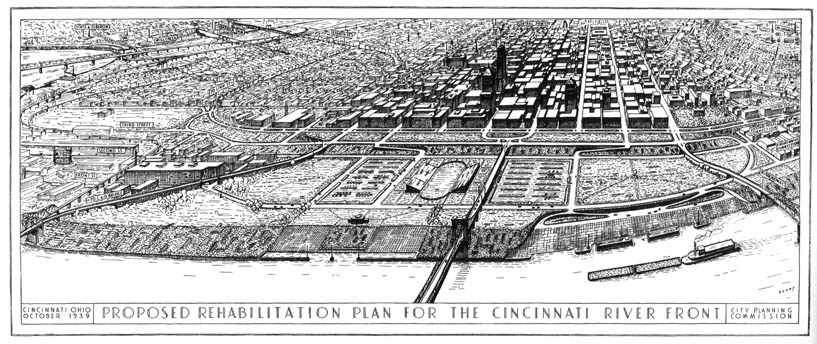Thursday, October 20, 2005
The Banks... What Have We Learned
I was browsing today at Cincinnati Transit.net. Lots of great photos and links, and such. Really interesting seeing pictures of transportation developments through the decades. One article with discussin of Fort Washington Way really caught my attention. But not for the comments about FWW. Rather check out these pictures of riverfront development plans from 1939, 1948 and 1999.
Picture from 1939. Notice the large parks and football stadium/race track in the middle.

Picture from 1948... again, FWW across dowtown. Large stadium on West side, and parks and museum across central and east side.

1999 picture.... what's different? Not much other than it's in color. FWW across the top. Stadium (now 2 one east one west), and parks/museum from central to east. How thinks it's time to build it instead of making redevelopment plans?

Thanks to a post on urbanohio.com for cluing me in to the cincinnati transit site!
Picture from 1939. Notice the large parks and football stadium/race track in the middle.

Picture from 1948... again, FWW across dowtown. Large stadium on West side, and parks and museum across central and east side.

1999 picture.... what's different? Not much other than it's in color. FWW across the top. Stadium (now 2 one east one west), and parks/museum from central to east. How thinks it's time to build it instead of making redevelopment plans?

Thanks to a post on urbanohio.com for cluing me in to the cincinnati transit site!
Comments:
<< Home
Actually, anonymous, in urban planning terminology, a plan is essentially a map of what you intend to do. Thus, these are indeed plans.
I would, though, disagree with Joe's assessment that there's nothing different about the '99 Banks proposal from the previous ones. It was really a dumb idea to ever cut the freeway through downtown and put stadiums on the riverfront in the first place, but the major, and most important difference between the '99 plan and the '48 plan is that in '99, they've finally rediscovered the logic of a continuous street grid that intends to reconnect the city fabric. The winding roads in the '48 plan are for cars. The streets in the Banks project are for people. There's a very significant difference there.
That said, unless they actually cap over FWW with buildings (NOT parks because there would still be a psychological void) and increase the heights of the buildings in the Banks area, it won't succeed. There won't be any life in that area unless there's a critical mass of people who live and work there. Six-storey buildings aren't gonna cut it.
Post a Comment
I would, though, disagree with Joe's assessment that there's nothing different about the '99 Banks proposal from the previous ones. It was really a dumb idea to ever cut the freeway through downtown and put stadiums on the riverfront in the first place, but the major, and most important difference between the '99 plan and the '48 plan is that in '99, they've finally rediscovered the logic of a continuous street grid that intends to reconnect the city fabric. The winding roads in the '48 plan are for cars. The streets in the Banks project are for people. There's a very significant difference there.
That said, unless they actually cap over FWW with buildings (NOT parks because there would still be a psychological void) and increase the heights of the buildings in the Banks area, it won't succeed. There won't be any life in that area unless there's a critical mass of people who live and work there. Six-storey buildings aren't gonna cut it.
<< Home

